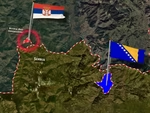Missing Persons Institute Spokesperson: We'll probably never find all victims

Of the 34,964 missing persons reported since the 1990s war in Bosnia and Herzegovina, 7,206 are still being sought, but as time passes, chances that all the missing persons will be found are getting slimmer, according to the spokesperson of the Missing Persons Institute of Bosnia and Herzegovina.
Some of those people will probably never be found because the bodies of many victims ended up in rivers and lakes, but Bosnia’s Missing Persons Institute is working intensively and exploring all options and sites on a daily basis, checking all available information in an effort to find the final locations of victims' graves, said the Institute's spokesperson Emza Fazlic.
She stressed that the Institute's investigators took to the field searching for mass graves about a thousand times in the first six months of this year alone.
"The passage of time is a big problem in the search for execution sites, as there are fewer and fewer people who know where mass graves are located, and those who do, unfortunately, do not want to talk about it," Fazlic said.
Time also affects the terrain, she said, making it difficult to locate mass graves.
"We do not cease to appeal to those who know, so they finally speak out and provide peace to the victims themselves and their families," she said.
She stated figures, saying that the Institute has found more than 800 mass graves and thousands of individual graves across the country to date. The largest number was found in the eastern area of Srebrenica.
Political leaders should do more to aid in the search for missing persons and help by opening up archives which could contain important information, she said.
"Given that the most difficult cases when it comes to the search for the missing are now remaining, the state should put the issue of the missing into the focus of its activities and provide the Institute with all the necessary resources to work," said Fazlic.
Although 24 years have passed since the end of the war, the Institute has been receiving information on potential burial sites daily.
Fazlic explained that information about potential graves is mostly obtained by word of mouth, and therefore there is no other way to verify the accuracy of this information other than to conduct an exhumation.
"Although witnesses who tell us about these sites claim with great certainty that mass graves are located in those locations, it often turns out that this information is incorrect," she said.
She also said that there were some people who were reported missing but are still alive.
"According to the data we currently have, we have information that 911 of the people were reported to us that they are alive. These cases are being thoroughly checked and so far 664 people have been definitely confirmed to be alive and have been deleted from our registry," said Fazlic.
Kakvo je tvoje mišljenje o ovome?
Učestvuj u diskusiji ili pročitaj komentare





 Srbija
Srbija
 Hrvatska
Hrvatska
 Slovenija
Slovenija



























































